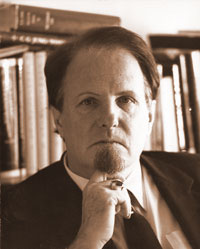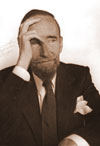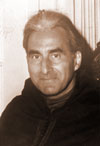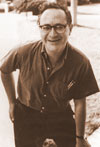
| Home | |
| About the Author | |
| About the Book | |
| Foreword | |
| Prelude | |
| Contents | |
| Reviews | |
| Links | |
| Contact | |
| Ordering |
![]()
Foreword
“A Hermetic Life”
By Stephan A. Hoeller
 |
| Stephan A. Hoeller |
C.G. Jung began his noted autobiographical reflections with the sentence: “My life is a story of the self-realization of the unconscious”. As in Jung’s life so in every man’s and woman’s life a great mystery seeks its expression. Still, the lives of a great many succeed only to a modest degree when bringing this inner mystery to consciousness. Those who make great strides in this respect are inevitably few in number, although, like the proverbial salt of the earth, they provide the lives of the rest of us with the inimitable flavor of a greater and better reality.
The late James Christopher Ingebretsen was just such an extraordinary person who belonged to the small number of the knowers of the things that are and the providers of such knowledge and meaning to others. His was a journey that covered the territory of the outer world, while it penetrated into the mysterious interior of existence. He led a life that most persons in our culture would view as both successful and exciting. Still, his true successes and greatest adventures were not in the outer sphere of his life, but rather in an inner world of mystery, where the great powers of primordial meaning and transformation hold sway. His meetings with statesmen, captains of industry, and the leading figures of culture and of the arts, his several careers in the fields of jurisprudence, public affairs and religion, all pale beside the interior adventures and movements of his soul. Rewarding as a recollection of his outward life might be his encounters with the inward life of meaning and spirit are of yet greater value and applicability.
All people, at all times, and under all circumstances lead two lives. One of these is a life in time, and must therefore be expressed by words and images gathered from the world of temporal events. The other, however, is always a life that is lived sub specie aeternitatis, in an aspect outside of time. Temporal tools do not suffice for the expression of this life; only the timeless dimensions of myth can begin to bring us intimations of it.
When I met James Ingebretsen in the late 1970’s he was on the verge of discovering the myth of his life, or as some would call it, his “personal myth”. After spending some hours with him, reviewing a number of his dreams and waking visions I suggested to him that his life appeared to be an expression of the ancient archetype of wisdom, known variously as Mercury, Hermes and Thoth.
Thoth, Hermes, Mercury: Three forms of the same archetype of unitive and transformative wisdom. Thoth, the ancient, sublime lord of the deepest mysteries of the unconscious; Hermes, swift, perceptive and knowing in his role of mediatorship and messengership; and Mercury, mischievous, patron of commerce and of travel, as well as of roguery and tricksterism. This is the trinity of the Hermetic archetypal image; such are the three faces of the power that symbolized wisdom to the peoples of Egypt, Greece and Rome for centuries unnumbered, and that is still alive today in the souls of men and women everywhere.
Of the three deific archetypes, Mercury is the most youthful and also the most mundane. For this reason, Mercury is the god most suited for expression in the life of a young person who is about to enter the arena of life in the world. Understandably, though significantly, this was the archetype that manifested in the early life of our protagonist. Young Ingebretsen’s was not the dull, conventional life of the typical “upwardly mobile” member of the middle class, or of any class. The puritanical virtues of systematic, plodding attachment to a chosen career had no hold on his soul and life. He moved freely from university to lumber camp and back to university again, all along profiting heavily from his proficiency in the games of poker and bridge. He moved from law firm to political campaign organization and high legal office in the nation’s capital, motivated not by ordinary ambition and even less by greed, but by the vital energy and fun of the “game”. His success was due not to hard work and virtue alone, but to a motivation that had more in common with gamesmanship than with striving for the goals exalted by society. There can be little doubt that from his youth until 1955 he was overshadowed by, and was in part living out the energies of the most external but nevertheless very important Hermetic archetype, that of Mercury.
In mid-life, Mercury needs to give way to his archetypal predecessor, Hermes. While in the earlier phase of life Mercury found his delight in the playful conjunction of the opposites in the external life of the individual, delighting in all manner of creative play from winning at a game of cards to a clever business transaction or a love affair, the coming of Hermes heralds the deepening of the keynote of creativity and transformation. Still, the archetype of Hermes is not very far removed from that of Mercury, and the operations of the two gods frequently overlap, especially in the earlier years when the “changing of the guard” may be said to take place. Whatever life the person may have been leading, the coming of Hermes can be counted on to disrupt and upset its workings. Jobs, marriages, established patterns of living are likely to undergo radical and at times alarming changes.
The arrival of Hermes always brings with it a certain element of drama. A middle-aged executive falling in love with his youthful secretary or a previously contented housewife and mother leaving her household to set up bohemian housekeeping in Greenwich Village are dramatic events in spite of their incongruity. Still, at other times the drama takes a different and more mysterious form. James Ingebretsen experienced a well-nigh classical conversion experience (metanoia) at a Salvation Army chapel in 1955. Outwardly, nothing could appear less Hermetic than a spiritual drama under such commonplace Christian circumstances. The spirit of Hermes, however, like all holy spirits, “bloweth where it listeth”, and certainly the abode of fundamentalist Christianity does not constitute an exception to this rule. The Mercurial thief came and stole the comfortable life of the brilliant man of the world. Whether Hermes or Christ, the god ever comes as a thief in the night, and the goods he absconds with are inevitably irretrievable. It is worthy of note that Hermes was the one and only pagan deity who was regarded favorably by the Christian Church, even to the point of having been viewed as a prototype and forerunner of the Saviour. The heterodox tradition of the Gnostic Gospels treats Jesus openly as a Hermetic figure who came into the world not in order to save sinners, but to make the above and the below, the inner and the outer, and the male and the female into a single one. Little wonder then, that, James Ingebretsen, a natural Gnostic if there ever was one, should have encountered Hermes in the guise of Jesus Christ, within the confines of a place of worship of the Salvation Army. The result was not a conversion to a fundamentalist form of religiosity, but rather the deepening of a life of the spirit along universal lines of thought.
As patron of divination and other magical operations, Hermes is also the ruler of what C.G. Jung called synchronicity, the meaningful occurrence of several causally unrelated events in time, which constellate themselves around an emerging archetypal presence. James Ingebretsen, like all psychically sensitive people experienced many synchronicities, not the least of which having been his fated meeting with the unusual philosopher and Hermetic psychopomp, Gerald Heard; a meeting that occurred in the aftermath of his own shattering conversion experience. Occurrences of a like kind are certainly not unknown in the life stories of persons undergoing profound spiritual transformations. The “friends of God”, wandering messengers of the spirit, who appear at critical moments in the process of interior alchemy are of many aspects and make their appearance in strange ways. Their gifts are unpredictable, but always helpful.
 |
| Gerald Heard |
 |
| Pir Zade Vilayat Inayat Khan |
 |
| Ira Progoff |
Hermetic facilitators, admitted to the stage of the lives of persons undergoing profound transformations often influence the transformed person to become a Hermetic facilitator himself. Such was the case with James Ingebretsen. He became an associate of Manly Palmer Hall, and corporate counsel of the Philosophical Research Society; it was in the lecture room of that Society that I met him after one of my evening lectures on the subject of the Holy Grail. He also facilitated the work of his mentor, Gerald Heard, as well as that of the Sufi Master, Pir Vilayat Inayat Khan, and the work also of Ira Progoff, a psychologist and disciple of C.G. Jung. The gratitude of countless students and readers of the works of these teachers, as well as others who profited from James Ingebretsen’s role as facilitator will ever accompany his memory.
The Hermetic life of James Ingebretsen now was at the summit of its power. He had seen the light of heaven and did his best to shed a measure of that light unto the world. Still, there was yet another god-image to make its appearance in his life. Thoth, lord of the dark night of the soul, bringer of the light that shines in the darkness had come. In the case of our protagonist, Thoth came literally under the cover of darkness; a darkness that was brought by loss of physical sight. Overnight he almost completely lost the sight of both of his eyes.
It is often thus. In some instances, other infirmities or severely limiting circumstances come to destroy the luminous world built by Hermes in previous, happier years. The world darkens, one’s powers are diminished, destruction hovers about as if in an image of somber, Pharaonic myths. The great crisis of the soul has come. Thoth the mighty has struck with his magic wand and darkness has descended. A portentous choice now offers itself to the soul. It is the choice between despair and perseverance. One must persevere in the pursuit of the light, but this light is now no longer primarily the light of the outer world, but the midnight sun shining in the dark kingdom into which Thoth introduces our souls.
Unlike others who descend into despair and depression, the heroic soul of James Ingebretsen rose to the challenge presented to him by the darkening of the outer world. As the outer world darkened, his inner light brightened. As his body grew frail, his spirit grew in strength. At the end of his long Hermetic life, the nonagenarian exited this darkened world in a style that was similar to the one he cultivated in life. In life and in death, his was a style and demeanour of one of life’s noblemen; a way that was as understated and private as it was elegant.
Such are some of the reflections which impelled me to pen this Foreword to the autobiographical work of my late friend. The myth of the man whom some of us knew as James C. Ingebretsen can be of value to all persons who recognize the need for a certain Gnosis in their lives and souls. Hermes may not be reborn with equal power in all men and women, but we may be sure that called or uncalled, he will be present. One moment we perceive him visibly in the daylight, in the next he may be hiding in the shadows. Most frequently the god will call attention to himself in our meetings with remarkable men and women in whose lives he found an arena to manifest. For my part, I am fortunate to have met such a man when I met James Ingebretsen. I also agree with C.G. Jung who said that some people’s names are entered in our scrolls of destiny from the beginning so that encountering them becomes in fact a kind of recollection. And if in this recollection one also received the boon of the presence of Hermes and was brushed and touched by the wings of his helmet and sandals — then one may feel truly blessed. Let us nourish the merciful hope that those who read the story of the life of this remarkable man will be similarly touched by the deific figure whose myth is intertwined, Caduceus-like, with the Hermetic life here described!
| © Copyright 2003 Apprentice to the Dawn Design by Hop Studios |
